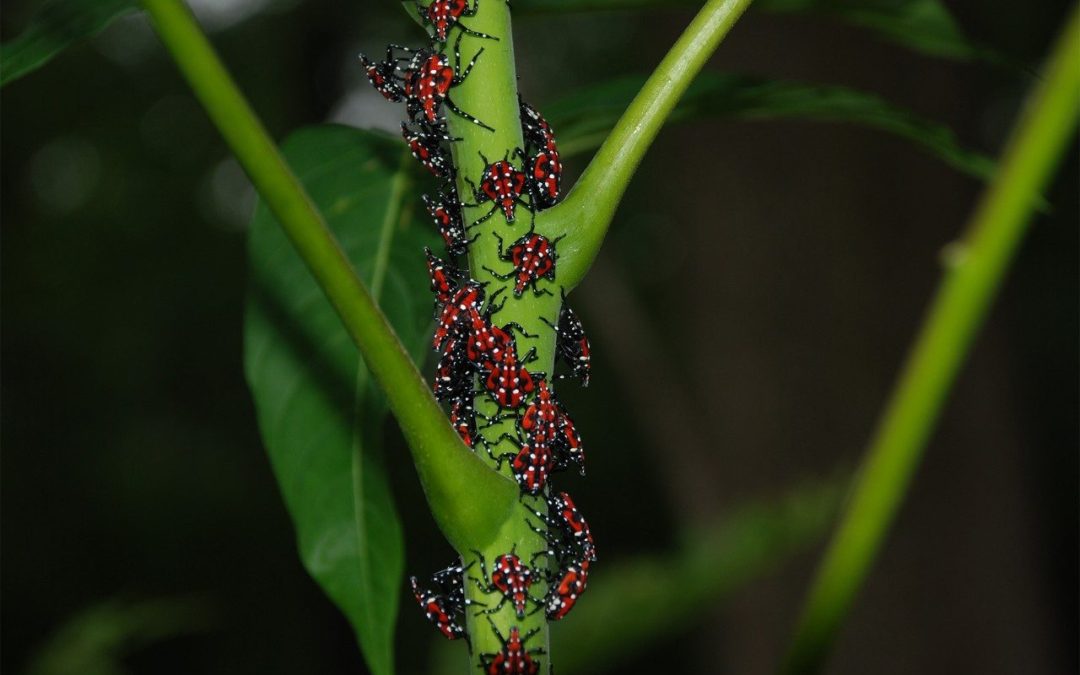Our landscape plants are under a constant and changing attack from insects, disease and environmental conditions. Most of the issues facing the landscape are normal, native insects and diseases. However, we are seeing a regular introduction of non-native, invasive species which are causing great damage. In the past we have seen Emerald Ash Borer, Gypsy Moth, Hemlock Woolly Adelgid, Dogwood Anthracnose and more. Now we are seeing a new pest invade our area which is going to be a long term, devastating pest.
This new kid on the block is the Spotted Lantern Fly (SLF) Lycorna delicatula. The Spotted Lantern Fly was introduced into Berks County, Pennsylvania in 2012 and is a native to China, Korea, Vietnam, and Japan. It was likely introduced on packaging material from China. SLF has since spread throughout southeastern Pennsylvania and is now in the Shenandoah Valley.
The Spotted Lantern Fly is not actually a fly; it is in the plant/leaf hopper family. They have piercing, sucking mouthparts similar to aphids. The mouth is like a small straw which the insect inserts into the plants leaves and bark to suck out the sap. This feeding causes a reduction in photosynthesis and depletes the energy reserves of the plant. In heavy, long term infestation the tree eventually looses leaves, stems, and limbs, causing severe decline or even killing the plant.
What Makes this Pest Different?
The SLF goes through a process known as incomplete metamorphosis which means it has several stages of nymphs who are wingless that grow and develop into winged adults. The first stages are small black insects with white spots, but the more advanced nymphs turn bright red and black with the white spots. The adults are approximately one inch in length, with grey wings which have black spots, the underside of the wings are red and the abdomen is red and yellow. The SLF is a very attractive insect but is also very destructive. Because of the incomplete metamorphosis, all life stages are seen together in the summer when the pest is active.
What Kind of Damage does the Spotted Latern Fly Cause?
The Spotted Lantern Fly infests a large range of trees and woody perennials. This includes fruit trees, grapes, oaks, Walnut, Willow, Sycamore, Poplar and Pine. Their primary host plant is the Ailanthus or Tree of Heaven which is also an invasive species from Asia. The SLF eggs hatch in the spring to early summer and the nymphs begin to feed. They will congregate in large groups, feeding on the tree.
As they feed, they excrete “honey dew” which is a high sugar content liquid. This honey dew drops onto every surface under the tree; it accumulates on leaves, stems, sidewalks, houses, cars causing a sticky mess and the growth of sooty mold. Sooty mold is a black mold which grows on the sugars and coats the surfaces with this black sooty substance. With high populations of SLF, the trees also weep from the damage, adding to this accumulation. Often a strong fermented odor is noticed and many flying insects, including bees, are attracted to the honey dew. All in all the SLF creates a big nasty mess.
What Can You Do to Stop Spotted Lantern Flies?
Fortunately, the Spotted Lantern Fly can be controlled with properly timed applications. Big O Tree and Lawn Service has been closely monitoring the advancement of this pest since it was first noted in 2014. We are well prepared to defend your landscapes from this invasion. Being prepared and informed is the first line of defense so take this pest seriously, be on the lookout and contact us at the first signs of activity.
